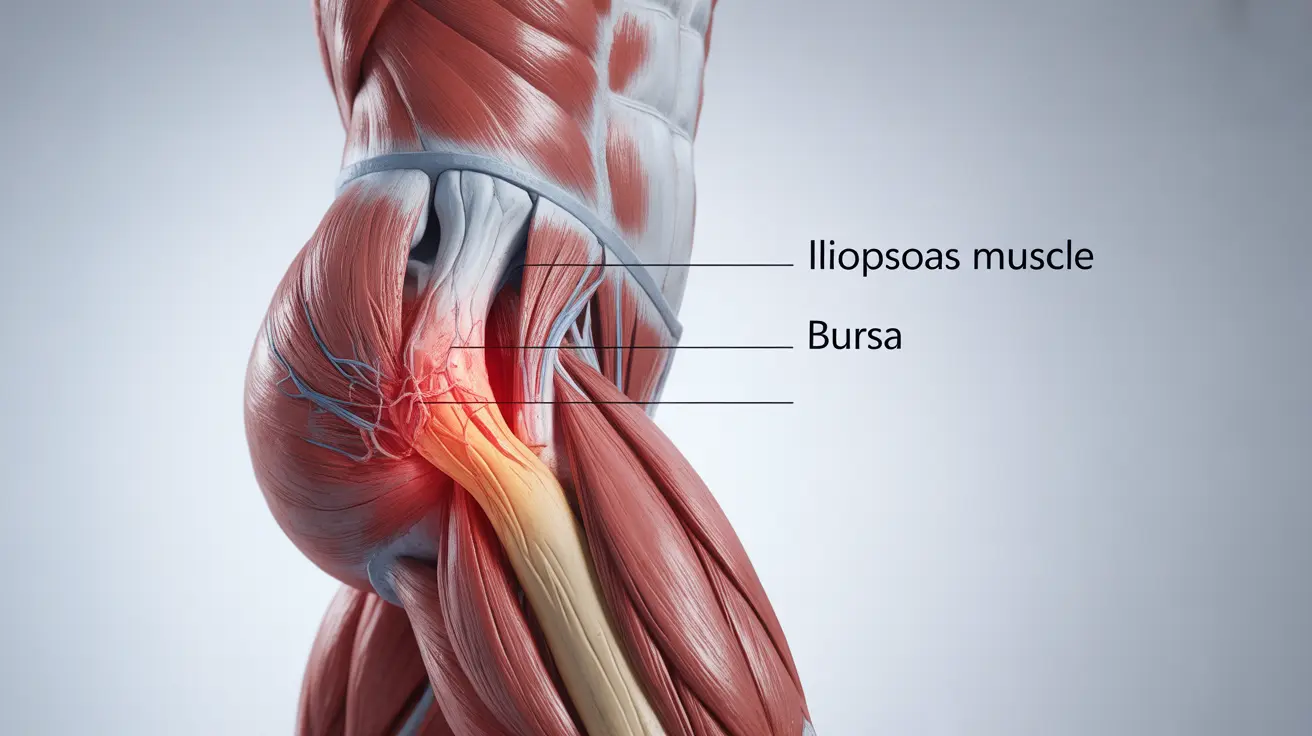Iliopsoas bursitis is a painful inflammatory condition affecting the iliopsoas bursa, a fluid-filled sac that helps reduce friction between the iliopsoas muscle and surrounding structures in the hip area. This condition can significantly impact daily activities and mobility, making it essential to understand its symptoms, causes, and treatment options.
While this condition can affect anyone, it's particularly common among athletes, dancers, and individuals who regularly engage in activities requiring repetitive hip movements. Early recognition and proper management are crucial for preventing chronic issues and maintaining optimal hip function.
Understanding Iliopsoas Bursitis and Its Impact
The iliopsoas bursa is the largest bursa in the body, located where the iliopsoas muscle passes in front of the hip joint. When this bursa becomes inflamed, it can cause significant discomfort and limit movement in the hip and groin area. Understanding the condition's nature is crucial for proper management and prevention.
Common Symptoms and Warning Signs
Recognizing the symptoms of iliopsoas bursitis is crucial for early intervention. Common signs include:
- Pain and tenderness in the groin area
- Discomfort when climbing stairs or getting up from a seated position
- Pain that worsens with hip extension
- Clicking or snapping sensation in the hip
- Stiffness after periods of inactivity
Risk Factors and Common Causes
Several factors can contribute to the development of iliopsoas bursitis:
- Repetitive hip flexion movements
- Overuse during sports activities
- Poor posture or biomechanics
- Previous hip surgery or trauma
- Rheumatoid arthritis or other inflammatory conditions
Diagnostic Process and Medical Evaluation
Healthcare providers typically use a combination of physical examination and imaging studies to diagnose iliopsoas bursitis. The diagnostic process may include:
- Detailed medical history review
- Physical examination of the hip
- MRI or ultrasound imaging
- X-rays to rule out other conditions
Treatment Approaches and Management Strategies
Conservative Treatment Options
Initial treatment typically focuses on conservative measures, including:
- Rest and activity modification
- Ice therapy for acute pain
- Anti-inflammatory medications
- Physical therapy exercises
- Gentle stretching routines
Advanced Treatment Methods
When conservative treatments aren't sufficient, healthcare providers may recommend:
- Corticosteroid injections
- Ultrasound-guided aspiration
- Modified exercise programs
- Manual therapy techniques
Prevention and Long-term Management
Preventing recurrence of iliopsoas bursitis involves several key strategies:
- Proper warm-up before physical activities
- Regular stretching of hip muscles
- Maintaining good posture
- Gradual progression in exercise intensity
- Core strengthening exercises
Frequently Asked Questions
1. What are the most common symptoms of iliopsoas bursitis and how can I recognize them? The most common symptoms include groin pain, discomfort during hip movements, pain when climbing stairs or rising from a seated position, and tenderness in the hip area. You may also notice increased pain with extended periods of activity.
2. What causes iliopsoas bursitis and who is at higher risk of developing it? Iliopsoas bursitis is typically caused by overuse, repetitive movements, trauma, or underlying inflammatory conditions. Athletes, dancers, and individuals who perform repetitive hip movements are at higher risk, as are those with previous hip injuries or surgery.
3. How is iliopsoas bursitis diagnosed by doctors and what imaging tests are used? Doctors diagnose iliopsoas bursitis through physical examination, medical history review, and imaging tests. MRI and ultrasound are commonly used to confirm the diagnosis and rule out other conditions. X-rays may be ordered to check for bone abnormalities.
4. What treatment options are available for iliopsoas bursitis, and how effective are corticosteroid injections? Treatment options range from conservative measures like rest, ice, and physical therapy to more advanced interventions like corticosteroid injections. Corticosteroid injections can be highly effective in reducing inflammation and pain, though results may vary among individuals.
5. How can I prevent iliopsoas bursitis, especially if I am an athlete or physically active person? Prevention strategies include proper warm-up routines, regular stretching, maintaining good posture, gradual progression in training intensity, and incorporating core strengthening exercises. Athletes should also ensure proper technique and avoid overtraining.




